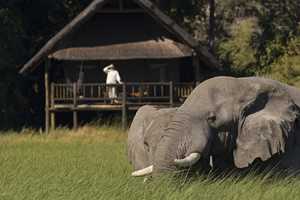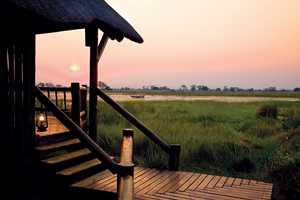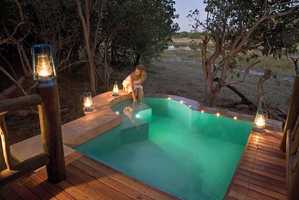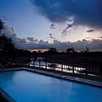Quick Facts: Botswana
- Land Area: 582,000 sq. km; almost 17% of which is protected wildlife area
- Population: 1.6 million (1999)
- Currency: Pula
- Urbanisation: 46%
- Capital city of Botswana: Gaborone
- Climate: Subtropical / Summer: 19-33°C, Winter: 5-23°C
- Languages: Official language: English / Setswana is the national language
- Measures: Metric System
- Electric Current: 220 volts
- Time: GMT + 2 Hours
- Day of independence: 30 September 1966
Introducing Botswana
Botswana borders South Africa to the south and east, Zimbabwe to the northeast and Namibia to the north. The tableland of the Kalahari Desert covers most of the country and the national parks cover an additional 17 per cent. The vast arid sandveld of the Kalahari occupies much of north, central and western Botswana.
Gaborone, the capital of Botswana, is located in the southeast of the country and is at the forefront of education, sport and culture. The University of Botswana, The National Museum and Art Gallery as well as the National Sports Stadium are all located in the city. Music and Drama is catered for at the Maitisong Cultural Centre.
Near to Gaborone is a dam with a yacht club offering sailing, and fishing; use of facilities is available to visitors at the invitation of a club member. 10km Southwest of the hotel is the privately operated, 3000 ha Mokolodi Nature Reserve, where visitors can go on guided game walks amongst the elephant, cheetah and antelope. Day trips can be made to see local crafts at Oodi, Thamaga and Pilane. A trip to the weaving centre at Lentswe-La-Odi, just north of Gaborone, is especially recommended as the local craftwork can be bought at a fraction of the normal price.
Botswana's National Parks and Game Reserves are a great attraction. The Okavango Delta area, northwards in the Kalahari Desert, is home to more than 300 exotic species and a variety of fauna. It is extremely beautiful, composed of vast grass flats, low tree-covered ridges and lagoons.
The Moremi Wildlife Reserve in southern Africa, covering 1812 sq km in the northeast corner of the Okavango Delta, is spectacular. Small boats travel the delta through lagoons abundant with birdlife. Most lodges and safari camps have restaurants and licensed bars.Botswana's magnificent wildlife can be observed in the national parks. Visits can be arranged independently or with tour operators.
Botswana is particularly good for horseback safaris and it is also possible to go on elephant-back safaris. Entry permits are required for all reserves. The best time of year to visit the parks is between April and October: the game is more difficult to see in the rainy months when the grass is high and there is plenty of water around, so the game does not have to rely on the waterholes and moves off into remote areas. In the dry winter season however, the animals congregate around water sources.
The summer in Botswana which is between October and April is very hot combined with a rainy season. Dry and cooler weather exists between May and September with an average temperature of 25ºC. Early mornings and evenings may be cold and frosty in winter. Annual rainfall decreases westwards and southwards.Botswana is a multi party democracy, governed since independence by the Botswana Democratic Party. Since the retirement of Sir Ketumile Masire. Mr Festus Mogae is president of the Republic. Ten other parties are recognized, the strongest of which is the Botswana National Front. Elections are held every five years in Botswana.
Botswana is made up of a number of tribes which include the Bakgatla, Bamalete, Bamangwato, Barolong, Bangwaketse, Bakwena, Batlokwa, Batawana, Bakalanga, Basarwa, Bakgalagadi, and Maun . Eighty percent of the population of Botswana are rural inhabitants.The main ethnic groups are the Batswana (descendants of iron-age immigrants from Central West Africa), the Basarwa (San, indigenous hunter-gatherers. pre iron-age), and the Herero (pastoralists).
Diamonds, vehicles, copper/nickel, beef and textiles are exported from Botswana. Economic growth has mainly been through the mining of diamonds, copper-nickel, and soda-ash. However, beef is also a major income source, as is tourism.
For further details contact the Botswana Department of Tourism:
- Telephone: +267 395 3024
- Facsimile: +267 390 8675
















